E-Commerce's Impact on Retail Performance
VerifiedAdded on 2022/08/12
|15
|6195
|438
AI Summary
This report discusses the significant role that e-commerce has played in modern business and the retail industry in particular.
The report highlights the benefits of e-commerce in improving the efficiency and effectiveness of businesses and its ability to add value to the supply chain process, which has a direct impact on business performance.
The report explores factors that have driven the growth of the e-commerce sector, including lower prices and the reduction of search costs.
Despite the positive impact of e-commerce, the report also acknowledges the challenges associated with the adoption of e-commerce in the retail sector.
Contribute Materials
Your contribution can guide someone’s learning journey. Share your
documents today.
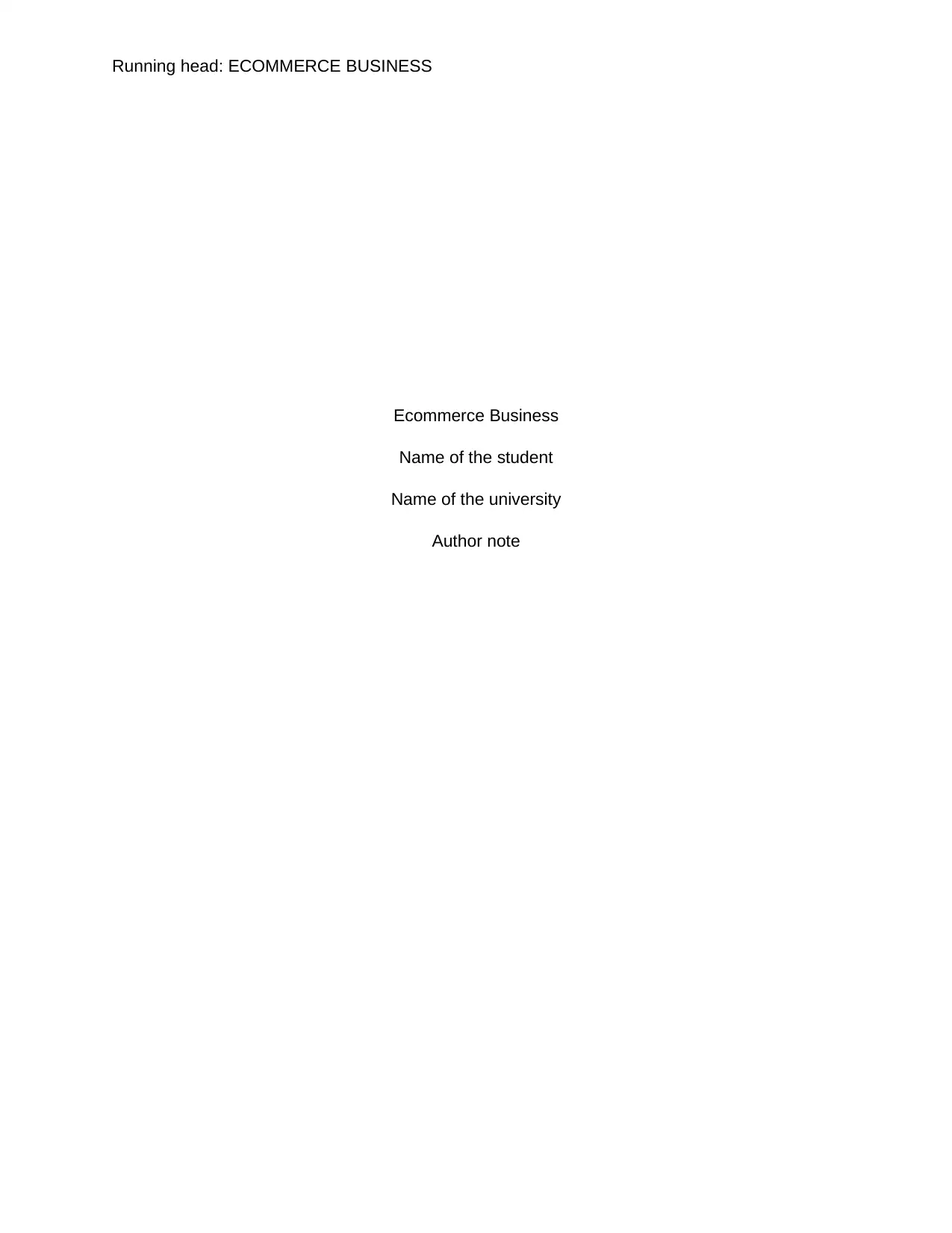
Running head: ECOMMERCE BUSINESS
Ecommerce Business
Name of the student
Name of the university
Author note
Ecommerce Business
Name of the student
Name of the university
Author note
Secure Best Marks with AI Grader
Need help grading? Try our AI Grader for instant feedback on your assignments.
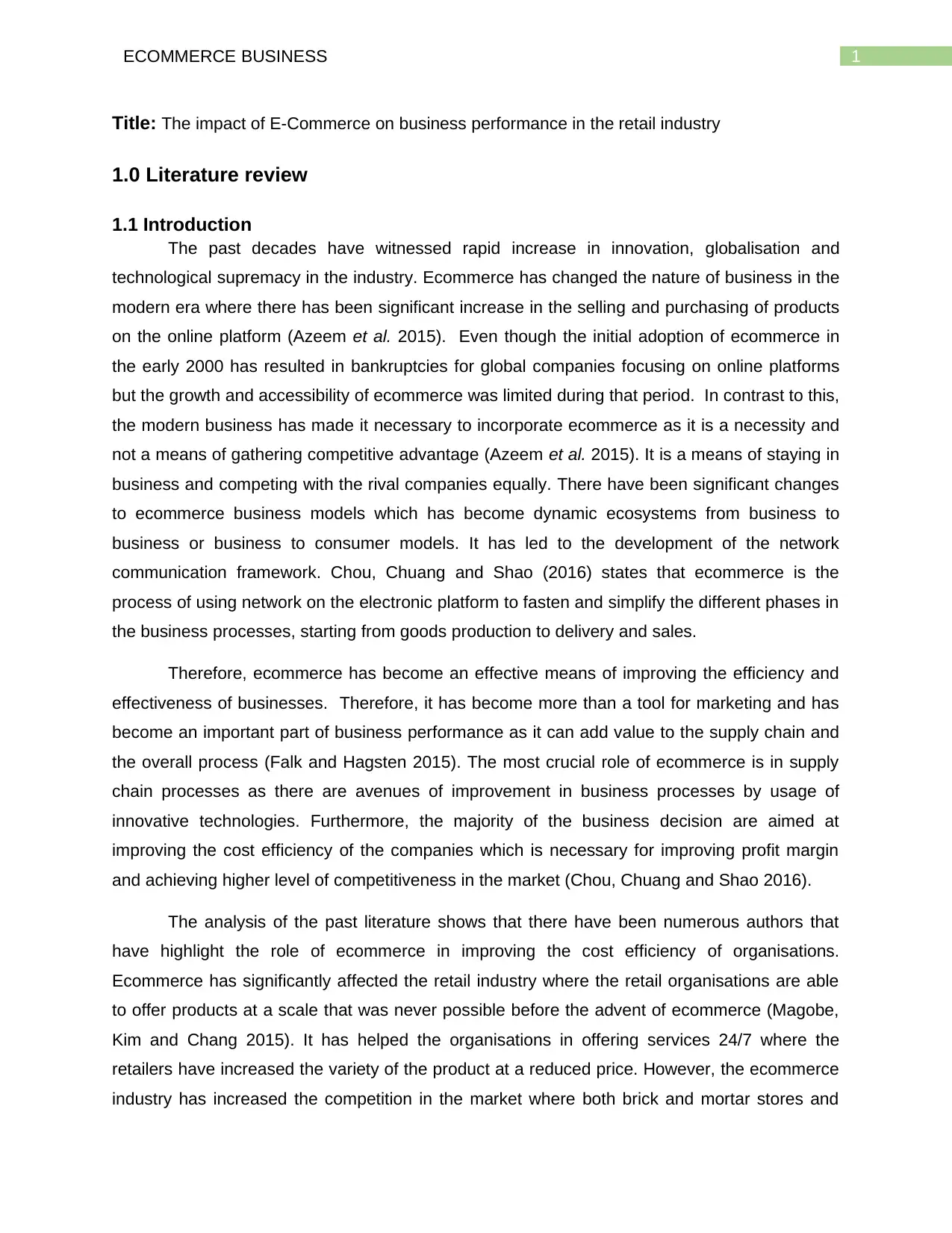
1ECOMMERCE BUSINESS
Title: The impact of E-Commerce on business performance in the retail industry
1.0 Literature review
1.1 Introduction
The past decades have witnessed rapid increase in innovation, globalisation and
technological supremacy in the industry. Ecommerce has changed the nature of business in the
modern era where there has been significant increase in the selling and purchasing of products
on the online platform (Azeem et al. 2015). Even though the initial adoption of ecommerce in
the early 2000 has resulted in bankruptcies for global companies focusing on online platforms
but the growth and accessibility of ecommerce was limited during that period. In contrast to this,
the modern business has made it necessary to incorporate ecommerce as it is a necessity and
not a means of gathering competitive advantage (Azeem et al. 2015). It is a means of staying in
business and competing with the rival companies equally. There have been significant changes
to ecommerce business models which has become dynamic ecosystems from business to
business or business to consumer models. It has led to the development of the network
communication framework. Chou, Chuang and Shao (2016) states that ecommerce is the
process of using network on the electronic platform to fasten and simplify the different phases in
the business processes, starting from goods production to delivery and sales.
Therefore, ecommerce has become an effective means of improving the efficiency and
effectiveness of businesses. Therefore, it has become more than a tool for marketing and has
become an important part of business performance as it can add value to the supply chain and
the overall process (Falk and Hagsten 2015). The most crucial role of ecommerce is in supply
chain processes as there are avenues of improvement in business processes by usage of
innovative technologies. Furthermore, the majority of the business decision are aimed at
improving the cost efficiency of the companies which is necessary for improving profit margin
and achieving higher level of competitiveness in the market (Chou, Chuang and Shao 2016).
The analysis of the past literature shows that there have been numerous authors that
have highlight the role of ecommerce in improving the cost efficiency of organisations.
Ecommerce has significantly affected the retail industry where the retail organisations are able
to offer products at a scale that was never possible before the advent of ecommerce (Magobe,
Kim and Chang 2015). It has helped the organisations in offering services 24/7 where the
retailers have increased the variety of the product at a reduced price. However, the ecommerce
industry has increased the competition in the market where both brick and mortar stores and
Title: The impact of E-Commerce on business performance in the retail industry
1.0 Literature review
1.1 Introduction
The past decades have witnessed rapid increase in innovation, globalisation and
technological supremacy in the industry. Ecommerce has changed the nature of business in the
modern era where there has been significant increase in the selling and purchasing of products
on the online platform (Azeem et al. 2015). Even though the initial adoption of ecommerce in
the early 2000 has resulted in bankruptcies for global companies focusing on online platforms
but the growth and accessibility of ecommerce was limited during that period. In contrast to this,
the modern business has made it necessary to incorporate ecommerce as it is a necessity and
not a means of gathering competitive advantage (Azeem et al. 2015). It is a means of staying in
business and competing with the rival companies equally. There have been significant changes
to ecommerce business models which has become dynamic ecosystems from business to
business or business to consumer models. It has led to the development of the network
communication framework. Chou, Chuang and Shao (2016) states that ecommerce is the
process of using network on the electronic platform to fasten and simplify the different phases in
the business processes, starting from goods production to delivery and sales.
Therefore, ecommerce has become an effective means of improving the efficiency and
effectiveness of businesses. Therefore, it has become more than a tool for marketing and has
become an important part of business performance as it can add value to the supply chain and
the overall process (Falk and Hagsten 2015). The most crucial role of ecommerce is in supply
chain processes as there are avenues of improvement in business processes by usage of
innovative technologies. Furthermore, the majority of the business decision are aimed at
improving the cost efficiency of the companies which is necessary for improving profit margin
and achieving higher level of competitiveness in the market (Chou, Chuang and Shao 2016).
The analysis of the past literature shows that there have been numerous authors that
have highlight the role of ecommerce in improving the cost efficiency of organisations.
Ecommerce has significantly affected the retail industry where the retail organisations are able
to offer products at a scale that was never possible before the advent of ecommerce (Magobe,
Kim and Chang 2015). It has helped the organisations in offering services 24/7 where the
retailers have increased the variety of the product at a reduced price. However, the ecommerce
industry has increased the competition in the market where both brick and mortar stores and
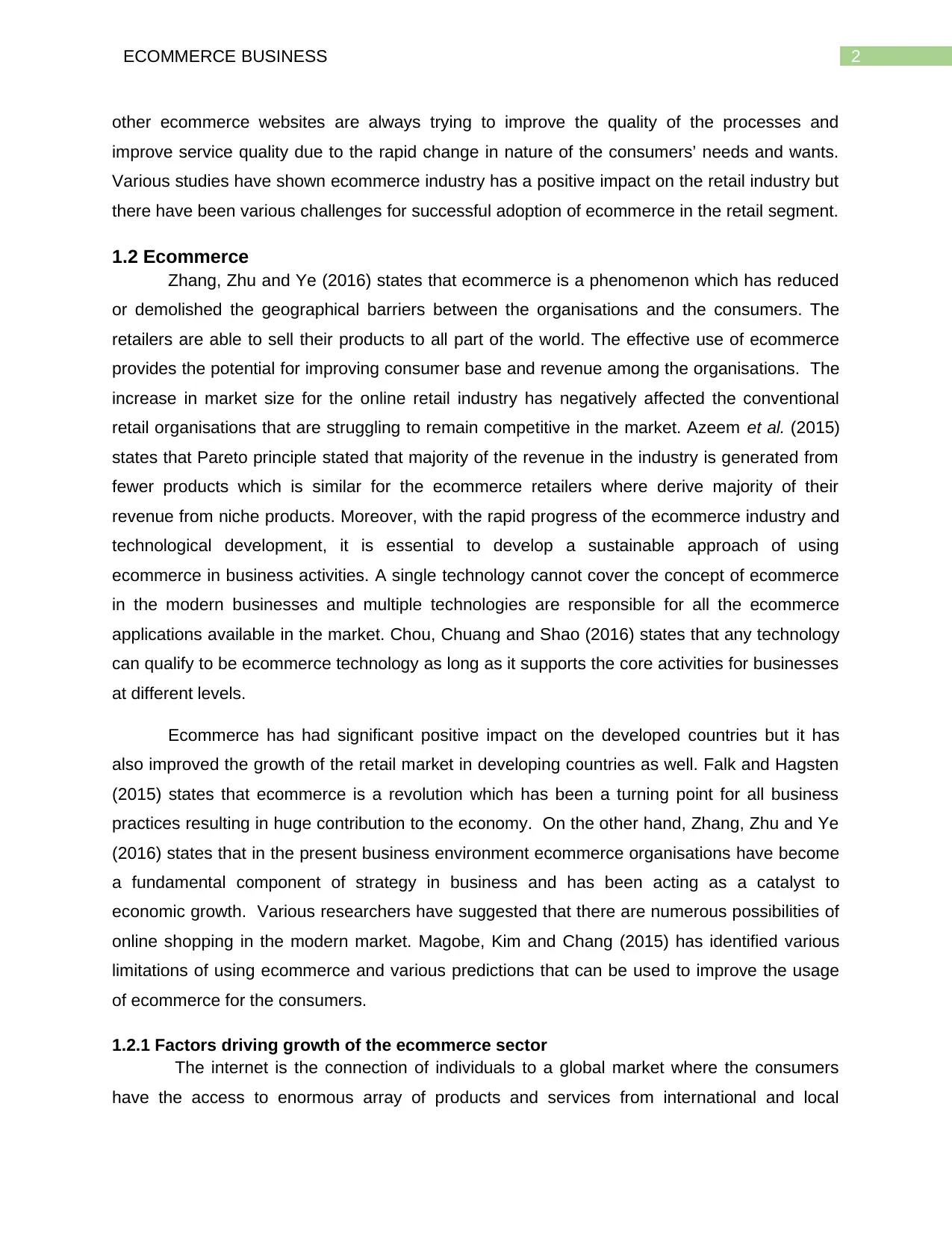
2ECOMMERCE BUSINESS
other ecommerce websites are always trying to improve the quality of the processes and
improve service quality due to the rapid change in nature of the consumers’ needs and wants.
Various studies have shown ecommerce industry has a positive impact on the retail industry but
there have been various challenges for successful adoption of ecommerce in the retail segment.
1.2 Ecommerce
Zhang, Zhu and Ye (2016) states that ecommerce is a phenomenon which has reduced
or demolished the geographical barriers between the organisations and the consumers. The
retailers are able to sell their products to all part of the world. The effective use of ecommerce
provides the potential for improving consumer base and revenue among the organisations. The
increase in market size for the online retail industry has negatively affected the conventional
retail organisations that are struggling to remain competitive in the market. Azeem et al. (2015)
states that Pareto principle stated that majority of the revenue in the industry is generated from
fewer products which is similar for the ecommerce retailers where derive majority of their
revenue from niche products. Moreover, with the rapid progress of the ecommerce industry and
technological development, it is essential to develop a sustainable approach of using
ecommerce in business activities. A single technology cannot cover the concept of ecommerce
in the modern businesses and multiple technologies are responsible for all the ecommerce
applications available in the market. Chou, Chuang and Shao (2016) states that any technology
can qualify to be ecommerce technology as long as it supports the core activities for businesses
at different levels.
Ecommerce has had significant positive impact on the developed countries but it has
also improved the growth of the retail market in developing countries as well. Falk and Hagsten
(2015) states that ecommerce is a revolution which has been a turning point for all business
practices resulting in huge contribution to the economy. On the other hand, Zhang, Zhu and Ye
(2016) states that in the present business environment ecommerce organisations have become
a fundamental component of strategy in business and has been acting as a catalyst to
economic growth. Various researchers have suggested that there are numerous possibilities of
online shopping in the modern market. Magobe, Kim and Chang (2015) has identified various
limitations of using ecommerce and various predictions that can be used to improve the usage
of ecommerce for the consumers.
1.2.1 Factors driving growth of the ecommerce sector
The internet is the connection of individuals to a global market where the consumers
have the access to enormous array of products and services from international and local
other ecommerce websites are always trying to improve the quality of the processes and
improve service quality due to the rapid change in nature of the consumers’ needs and wants.
Various studies have shown ecommerce industry has a positive impact on the retail industry but
there have been various challenges for successful adoption of ecommerce in the retail segment.
1.2 Ecommerce
Zhang, Zhu and Ye (2016) states that ecommerce is a phenomenon which has reduced
or demolished the geographical barriers between the organisations and the consumers. The
retailers are able to sell their products to all part of the world. The effective use of ecommerce
provides the potential for improving consumer base and revenue among the organisations. The
increase in market size for the online retail industry has negatively affected the conventional
retail organisations that are struggling to remain competitive in the market. Azeem et al. (2015)
states that Pareto principle stated that majority of the revenue in the industry is generated from
fewer products which is similar for the ecommerce retailers where derive majority of their
revenue from niche products. Moreover, with the rapid progress of the ecommerce industry and
technological development, it is essential to develop a sustainable approach of using
ecommerce in business activities. A single technology cannot cover the concept of ecommerce
in the modern businesses and multiple technologies are responsible for all the ecommerce
applications available in the market. Chou, Chuang and Shao (2016) states that any technology
can qualify to be ecommerce technology as long as it supports the core activities for businesses
at different levels.
Ecommerce has had significant positive impact on the developed countries but it has
also improved the growth of the retail market in developing countries as well. Falk and Hagsten
(2015) states that ecommerce is a revolution which has been a turning point for all business
practices resulting in huge contribution to the economy. On the other hand, Zhang, Zhu and Ye
(2016) states that in the present business environment ecommerce organisations have become
a fundamental component of strategy in business and has been acting as a catalyst to
economic growth. Various researchers have suggested that there are numerous possibilities of
online shopping in the modern market. Magobe, Kim and Chang (2015) has identified various
limitations of using ecommerce and various predictions that can be used to improve the usage
of ecommerce for the consumers.
1.2.1 Factors driving growth of the ecommerce sector
The internet is the connection of individuals to a global market where the consumers
have the access to enormous array of products and services from international and local
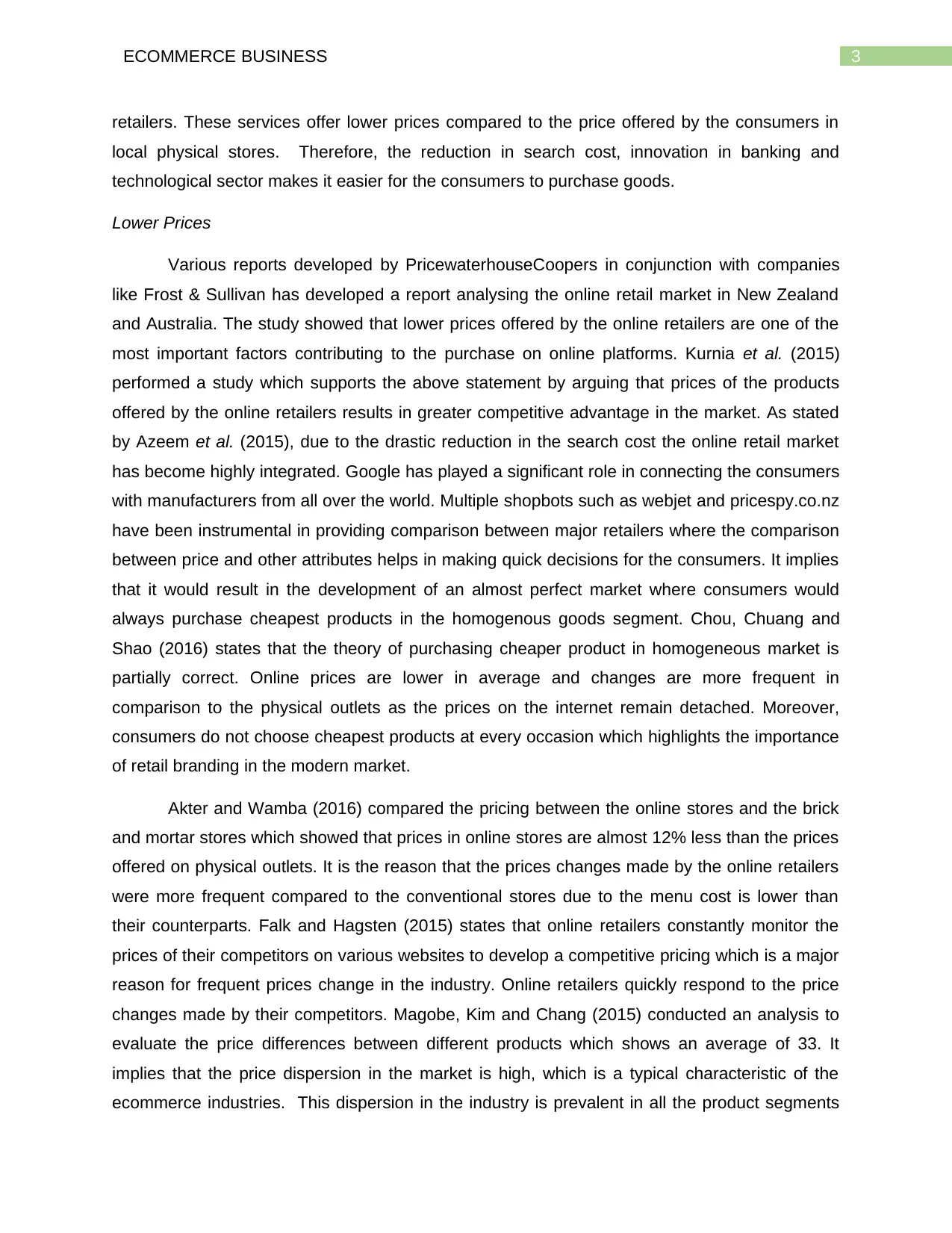
3ECOMMERCE BUSINESS
retailers. These services offer lower prices compared to the price offered by the consumers in
local physical stores. Therefore, the reduction in search cost, innovation in banking and
technological sector makes it easier for the consumers to purchase goods.
Lower Prices
Various reports developed by PricewaterhouseCoopers in conjunction with companies
like Frost & Sullivan has developed a report analysing the online retail market in New Zealand
and Australia. The study showed that lower prices offered by the online retailers are one of the
most important factors contributing to the purchase on online platforms. Kurnia et al. (2015)
performed a study which supports the above statement by arguing that prices of the products
offered by the online retailers results in greater competitive advantage in the market. As stated
by Azeem et al. (2015), due to the drastic reduction in the search cost the online retail market
has become highly integrated. Google has played a significant role in connecting the consumers
with manufacturers from all over the world. Multiple shopbots such as webjet and pricespy.co.nz
have been instrumental in providing comparison between major retailers where the comparison
between price and other attributes helps in making quick decisions for the consumers. It implies
that it would result in the development of an almost perfect market where consumers would
always purchase cheapest products in the homogenous goods segment. Chou, Chuang and
Shao (2016) states that the theory of purchasing cheaper product in homogeneous market is
partially correct. Online prices are lower in average and changes are more frequent in
comparison to the physical outlets as the prices on the internet remain detached. Moreover,
consumers do not choose cheapest products at every occasion which highlights the importance
of retail branding in the modern market.
Akter and Wamba (2016) compared the pricing between the online stores and the brick
and mortar stores which showed that prices in online stores are almost 12% less than the prices
offered on physical outlets. It is the reason that the prices changes made by the online retailers
were more frequent compared to the conventional stores due to the menu cost is lower than
their counterparts. Falk and Hagsten (2015) states that online retailers constantly monitor the
prices of their competitors on various websites to develop a competitive pricing which is a major
reason for frequent prices change in the industry. Online retailers quickly respond to the price
changes made by their competitors. Magobe, Kim and Chang (2015) conducted an analysis to
evaluate the price differences between different products which shows an average of 33. It
implies that the price dispersion in the market is high, which is a typical characteristic of the
ecommerce industries. This dispersion in the industry is prevalent in all the product segments
retailers. These services offer lower prices compared to the price offered by the consumers in
local physical stores. Therefore, the reduction in search cost, innovation in banking and
technological sector makes it easier for the consumers to purchase goods.
Lower Prices
Various reports developed by PricewaterhouseCoopers in conjunction with companies
like Frost & Sullivan has developed a report analysing the online retail market in New Zealand
and Australia. The study showed that lower prices offered by the online retailers are one of the
most important factors contributing to the purchase on online platforms. Kurnia et al. (2015)
performed a study which supports the above statement by arguing that prices of the products
offered by the online retailers results in greater competitive advantage in the market. As stated
by Azeem et al. (2015), due to the drastic reduction in the search cost the online retail market
has become highly integrated. Google has played a significant role in connecting the consumers
with manufacturers from all over the world. Multiple shopbots such as webjet and pricespy.co.nz
have been instrumental in providing comparison between major retailers where the comparison
between price and other attributes helps in making quick decisions for the consumers. It implies
that it would result in the development of an almost perfect market where consumers would
always purchase cheapest products in the homogenous goods segment. Chou, Chuang and
Shao (2016) states that the theory of purchasing cheaper product in homogeneous market is
partially correct. Online prices are lower in average and changes are more frequent in
comparison to the physical outlets as the prices on the internet remain detached. Moreover,
consumers do not choose cheapest products at every occasion which highlights the importance
of retail branding in the modern market.
Akter and Wamba (2016) compared the pricing between the online stores and the brick
and mortar stores which showed that prices in online stores are almost 12% less than the prices
offered on physical outlets. It is the reason that the prices changes made by the online retailers
were more frequent compared to the conventional stores due to the menu cost is lower than
their counterparts. Falk and Hagsten (2015) states that online retailers constantly monitor the
prices of their competitors on various websites to develop a competitive pricing which is a major
reason for frequent prices change in the industry. Online retailers quickly respond to the price
changes made by their competitors. Magobe, Kim and Chang (2015) conducted an analysis to
evaluate the price differences between different products which shows an average of 33. It
implies that the price dispersion in the market is high, which is a typical characteristic of the
ecommerce industries. This dispersion in the industry is prevalent in all the product segments
Secure Best Marks with AI Grader
Need help grading? Try our AI Grader for instant feedback on your assignments.
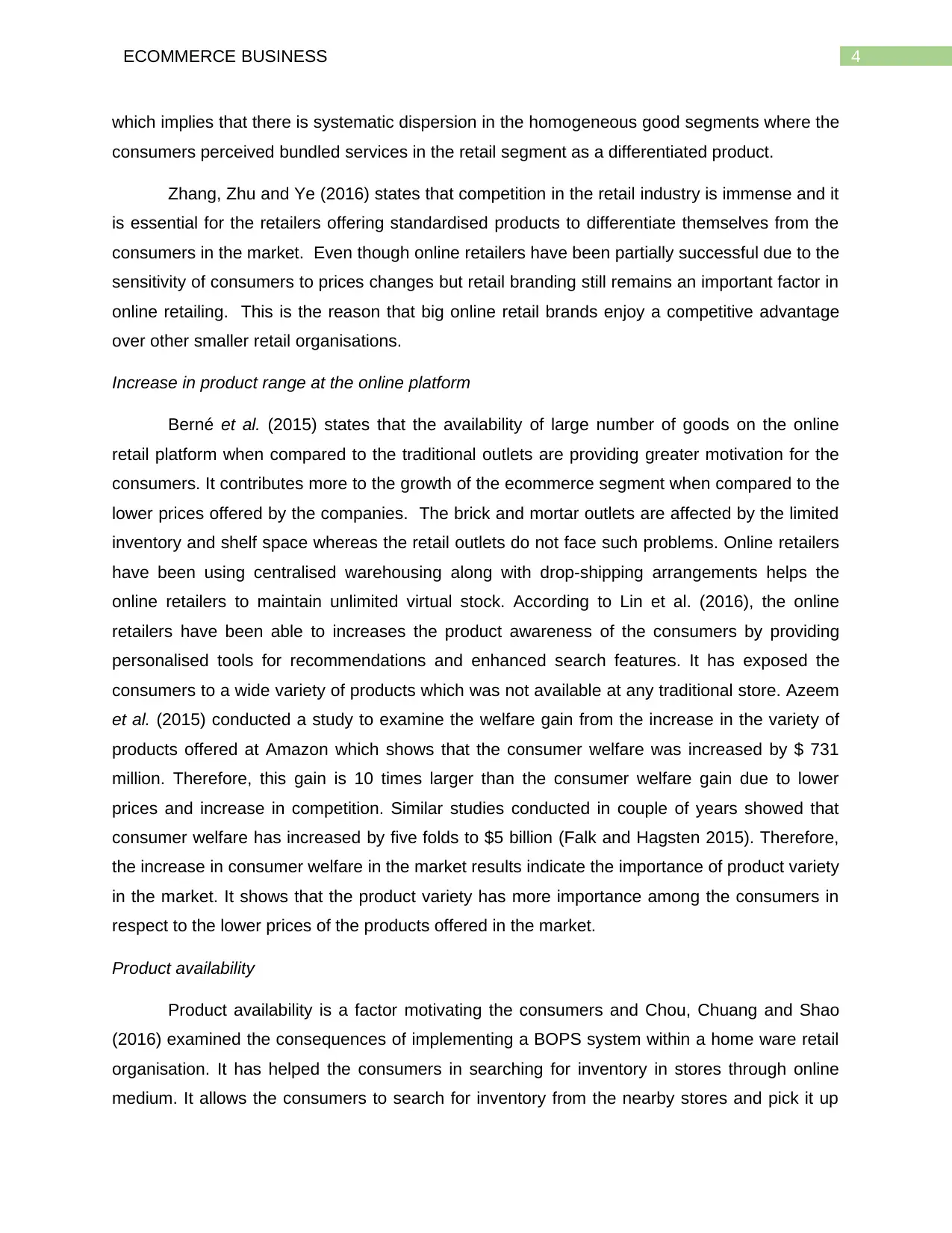
4ECOMMERCE BUSINESS
which implies that there is systematic dispersion in the homogeneous good segments where the
consumers perceived bundled services in the retail segment as a differentiated product.
Zhang, Zhu and Ye (2016) states that competition in the retail industry is immense and it
is essential for the retailers offering standardised products to differentiate themselves from the
consumers in the market. Even though online retailers have been partially successful due to the
sensitivity of consumers to prices changes but retail branding still remains an important factor in
online retailing. This is the reason that big online retail brands enjoy a competitive advantage
over other smaller retail organisations.
Increase in product range at the online platform
Berné et al. (2015) states that the availability of large number of goods on the online
retail platform when compared to the traditional outlets are providing greater motivation for the
consumers. It contributes more to the growth of the ecommerce segment when compared to the
lower prices offered by the companies. The brick and mortar outlets are affected by the limited
inventory and shelf space whereas the retail outlets do not face such problems. Online retailers
have been using centralised warehousing along with drop-shipping arrangements helps the
online retailers to maintain unlimited virtual stock. According to Lin et al. (2016), the online
retailers have been able to increases the product awareness of the consumers by providing
personalised tools for recommendations and enhanced search features. It has exposed the
consumers to a wide variety of products which was not available at any traditional store. Azeem
et al. (2015) conducted a study to examine the welfare gain from the increase in the variety of
products offered at Amazon which shows that the consumer welfare was increased by $ 731
million. Therefore, this gain is 10 times larger than the consumer welfare gain due to lower
prices and increase in competition. Similar studies conducted in couple of years showed that
consumer welfare has increased by five folds to $5 billion (Falk and Hagsten 2015). Therefore,
the increase in consumer welfare in the market results indicate the importance of product variety
in the market. It shows that the product variety has more importance among the consumers in
respect to the lower prices of the products offered in the market.
Product availability
Product availability is a factor motivating the consumers and Chou, Chuang and Shao
(2016) examined the consequences of implementing a BOPS system within a home ware retail
organisation. It has helped the consumers in searching for inventory in stores through online
medium. It allows the consumers to search for inventory from the nearby stores and pick it up
which implies that there is systematic dispersion in the homogeneous good segments where the
consumers perceived bundled services in the retail segment as a differentiated product.
Zhang, Zhu and Ye (2016) states that competition in the retail industry is immense and it
is essential for the retailers offering standardised products to differentiate themselves from the
consumers in the market. Even though online retailers have been partially successful due to the
sensitivity of consumers to prices changes but retail branding still remains an important factor in
online retailing. This is the reason that big online retail brands enjoy a competitive advantage
over other smaller retail organisations.
Increase in product range at the online platform
Berné et al. (2015) states that the availability of large number of goods on the online
retail platform when compared to the traditional outlets are providing greater motivation for the
consumers. It contributes more to the growth of the ecommerce segment when compared to the
lower prices offered by the companies. The brick and mortar outlets are affected by the limited
inventory and shelf space whereas the retail outlets do not face such problems. Online retailers
have been using centralised warehousing along with drop-shipping arrangements helps the
online retailers to maintain unlimited virtual stock. According to Lin et al. (2016), the online
retailers have been able to increases the product awareness of the consumers by providing
personalised tools for recommendations and enhanced search features. It has exposed the
consumers to a wide variety of products which was not available at any traditional store. Azeem
et al. (2015) conducted a study to examine the welfare gain from the increase in the variety of
products offered at Amazon which shows that the consumer welfare was increased by $ 731
million. Therefore, this gain is 10 times larger than the consumer welfare gain due to lower
prices and increase in competition. Similar studies conducted in couple of years showed that
consumer welfare has increased by five folds to $5 billion (Falk and Hagsten 2015). Therefore,
the increase in consumer welfare in the market results indicate the importance of product variety
in the market. It shows that the product variety has more importance among the consumers in
respect to the lower prices of the products offered in the market.
Product availability
Product availability is a factor motivating the consumers and Chou, Chuang and Shao
(2016) examined the consequences of implementing a BOPS system within a home ware retail
organisation. It has helped the consumers in searching for inventory in stores through online
medium. It allows the consumers to search for inventory from the nearby stores and pick it up
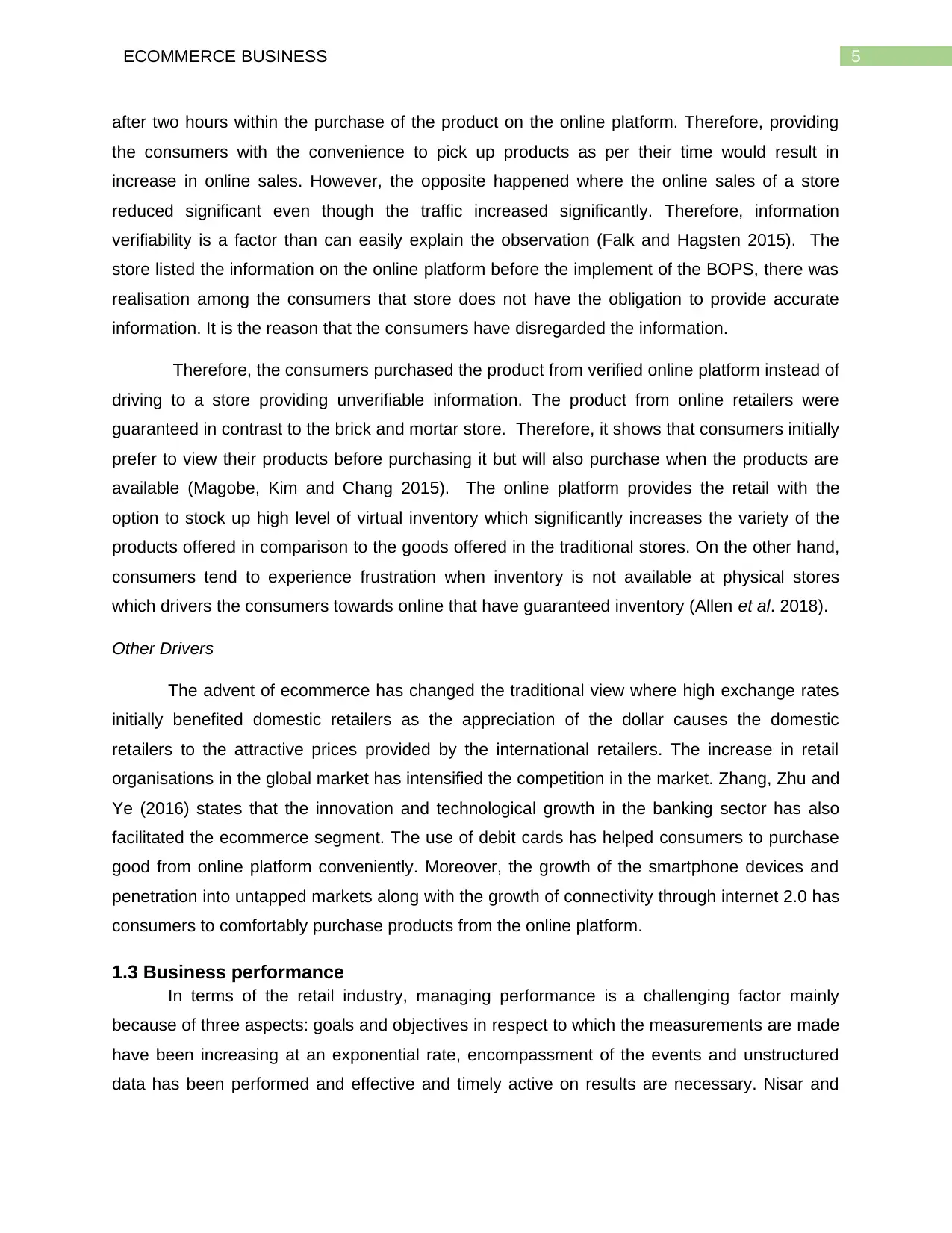
5ECOMMERCE BUSINESS
after two hours within the purchase of the product on the online platform. Therefore, providing
the consumers with the convenience to pick up products as per their time would result in
increase in online sales. However, the opposite happened where the online sales of a store
reduced significant even though the traffic increased significantly. Therefore, information
verifiability is a factor than can easily explain the observation (Falk and Hagsten 2015). The
store listed the information on the online platform before the implement of the BOPS, there was
realisation among the consumers that store does not have the obligation to provide accurate
information. It is the reason that the consumers have disregarded the information.
Therefore, the consumers purchased the product from verified online platform instead of
driving to a store providing unverifiable information. The product from online retailers were
guaranteed in contrast to the brick and mortar store. Therefore, it shows that consumers initially
prefer to view their products before purchasing it but will also purchase when the products are
available (Magobe, Kim and Chang 2015). The online platform provides the retail with the
option to stock up high level of virtual inventory which significantly increases the variety of the
products offered in comparison to the goods offered in the traditional stores. On the other hand,
consumers tend to experience frustration when inventory is not available at physical stores
which drivers the consumers towards online that have guaranteed inventory (Allen et al. 2018).
Other Drivers
The advent of ecommerce has changed the traditional view where high exchange rates
initially benefited domestic retailers as the appreciation of the dollar causes the domestic
retailers to the attractive prices provided by the international retailers. The increase in retail
organisations in the global market has intensified the competition in the market. Zhang, Zhu and
Ye (2016) states that the innovation and technological growth in the banking sector has also
facilitated the ecommerce segment. The use of debit cards has helped consumers to purchase
good from online platform conveniently. Moreover, the growth of the smartphone devices and
penetration into untapped markets along with the growth of connectivity through internet 2.0 has
consumers to comfortably purchase products from the online platform.
1.3 Business performance
In terms of the retail industry, managing performance is a challenging factor mainly
because of three aspects: goals and objectives in respect to which the measurements are made
have been increasing at an exponential rate, encompassment of the events and unstructured
data has been performed and effective and timely active on results are necessary. Nisar and
after two hours within the purchase of the product on the online platform. Therefore, providing
the consumers with the convenience to pick up products as per their time would result in
increase in online sales. However, the opposite happened where the online sales of a store
reduced significant even though the traffic increased significantly. Therefore, information
verifiability is a factor than can easily explain the observation (Falk and Hagsten 2015). The
store listed the information on the online platform before the implement of the BOPS, there was
realisation among the consumers that store does not have the obligation to provide accurate
information. It is the reason that the consumers have disregarded the information.
Therefore, the consumers purchased the product from verified online platform instead of
driving to a store providing unverifiable information. The product from online retailers were
guaranteed in contrast to the brick and mortar store. Therefore, it shows that consumers initially
prefer to view their products before purchasing it but will also purchase when the products are
available (Magobe, Kim and Chang 2015). The online platform provides the retail with the
option to stock up high level of virtual inventory which significantly increases the variety of the
products offered in comparison to the goods offered in the traditional stores. On the other hand,
consumers tend to experience frustration when inventory is not available at physical stores
which drivers the consumers towards online that have guaranteed inventory (Allen et al. 2018).
Other Drivers
The advent of ecommerce has changed the traditional view where high exchange rates
initially benefited domestic retailers as the appreciation of the dollar causes the domestic
retailers to the attractive prices provided by the international retailers. The increase in retail
organisations in the global market has intensified the competition in the market. Zhang, Zhu and
Ye (2016) states that the innovation and technological growth in the banking sector has also
facilitated the ecommerce segment. The use of debit cards has helped consumers to purchase
good from online platform conveniently. Moreover, the growth of the smartphone devices and
penetration into untapped markets along with the growth of connectivity through internet 2.0 has
consumers to comfortably purchase products from the online platform.
1.3 Business performance
In terms of the retail industry, managing performance is a challenging factor mainly
because of three aspects: goals and objectives in respect to which the measurements are made
have been increasing at an exponential rate, encompassment of the events and unstructured
data has been performed and effective and timely active on results are necessary. Nisar and
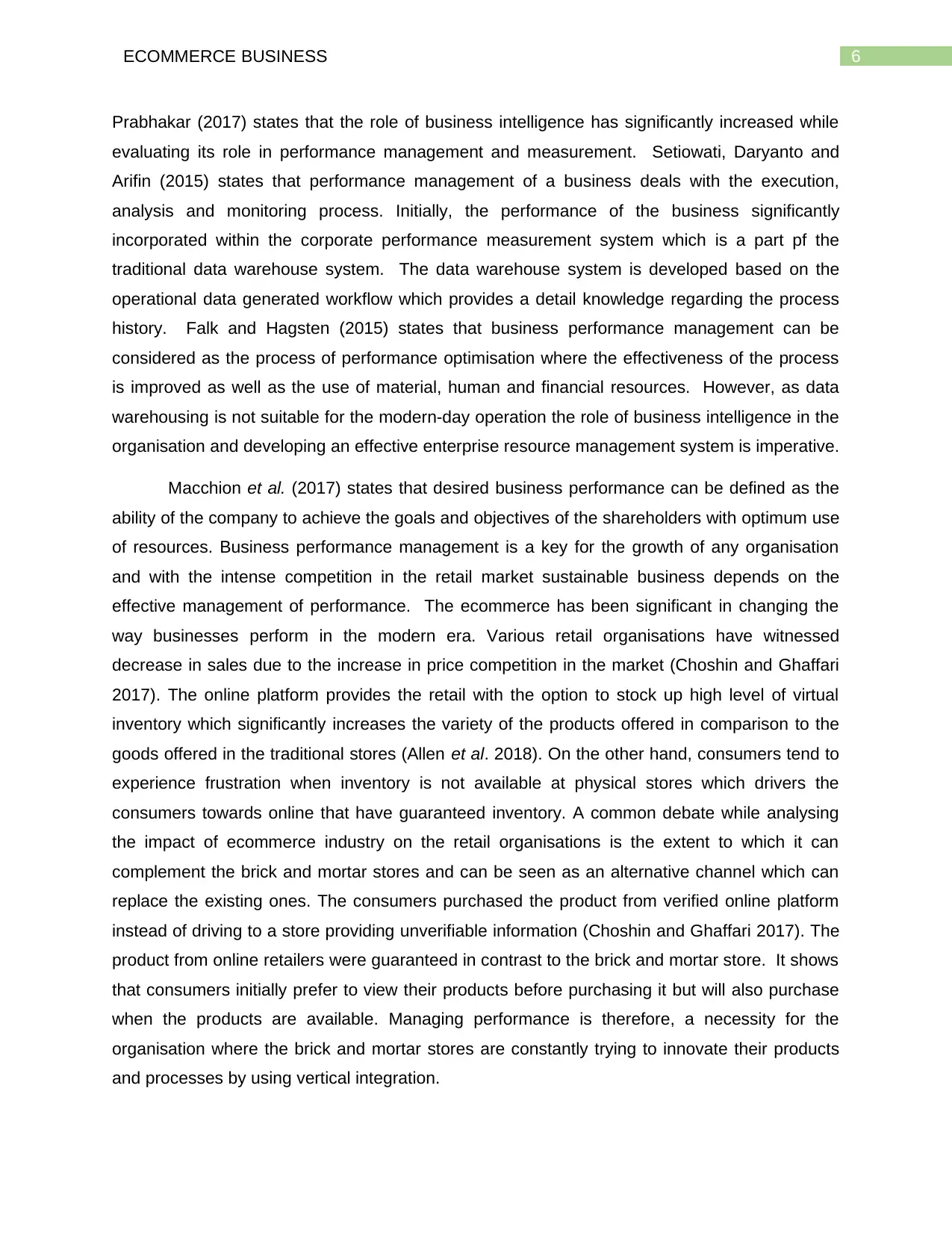
6ECOMMERCE BUSINESS
Prabhakar (2017) states that the role of business intelligence has significantly increased while
evaluating its role in performance management and measurement. Setiowati, Daryanto and
Arifin (2015) states that performance management of a business deals with the execution,
analysis and monitoring process. Initially, the performance of the business significantly
incorporated within the corporate performance measurement system which is a part pf the
traditional data warehouse system. The data warehouse system is developed based on the
operational data generated workflow which provides a detail knowledge regarding the process
history. Falk and Hagsten (2015) states that business performance management can be
considered as the process of performance optimisation where the effectiveness of the process
is improved as well as the use of material, human and financial resources. However, as data
warehousing is not suitable for the modern-day operation the role of business intelligence in the
organisation and developing an effective enterprise resource management system is imperative.
Macchion et al. (2017) states that desired business performance can be defined as the
ability of the company to achieve the goals and objectives of the shareholders with optimum use
of resources. Business performance management is a key for the growth of any organisation
and with the intense competition in the retail market sustainable business depends on the
effective management of performance. The ecommerce has been significant in changing the
way businesses perform in the modern era. Various retail organisations have witnessed
decrease in sales due to the increase in price competition in the market (Choshin and Ghaffari
2017). The online platform provides the retail with the option to stock up high level of virtual
inventory which significantly increases the variety of the products offered in comparison to the
goods offered in the traditional stores (Allen et al. 2018). On the other hand, consumers tend to
experience frustration when inventory is not available at physical stores which drivers the
consumers towards online that have guaranteed inventory. A common debate while analysing
the impact of ecommerce industry on the retail organisations is the extent to which it can
complement the brick and mortar stores and can be seen as an alternative channel which can
replace the existing ones. The consumers purchased the product from verified online platform
instead of driving to a store providing unverifiable information (Choshin and Ghaffari 2017). The
product from online retailers were guaranteed in contrast to the brick and mortar store. It shows
that consumers initially prefer to view their products before purchasing it but will also purchase
when the products are available. Managing performance is therefore, a necessity for the
organisation where the brick and mortar stores are constantly trying to innovate their products
and processes by using vertical integration.
Prabhakar (2017) states that the role of business intelligence has significantly increased while
evaluating its role in performance management and measurement. Setiowati, Daryanto and
Arifin (2015) states that performance management of a business deals with the execution,
analysis and monitoring process. Initially, the performance of the business significantly
incorporated within the corporate performance measurement system which is a part pf the
traditional data warehouse system. The data warehouse system is developed based on the
operational data generated workflow which provides a detail knowledge regarding the process
history. Falk and Hagsten (2015) states that business performance management can be
considered as the process of performance optimisation where the effectiveness of the process
is improved as well as the use of material, human and financial resources. However, as data
warehousing is not suitable for the modern-day operation the role of business intelligence in the
organisation and developing an effective enterprise resource management system is imperative.
Macchion et al. (2017) states that desired business performance can be defined as the
ability of the company to achieve the goals and objectives of the shareholders with optimum use
of resources. Business performance management is a key for the growth of any organisation
and with the intense competition in the retail market sustainable business depends on the
effective management of performance. The ecommerce has been significant in changing the
way businesses perform in the modern era. Various retail organisations have witnessed
decrease in sales due to the increase in price competition in the market (Choshin and Ghaffari
2017). The online platform provides the retail with the option to stock up high level of virtual
inventory which significantly increases the variety of the products offered in comparison to the
goods offered in the traditional stores (Allen et al. 2018). On the other hand, consumers tend to
experience frustration when inventory is not available at physical stores which drivers the
consumers towards online that have guaranteed inventory. A common debate while analysing
the impact of ecommerce industry on the retail organisations is the extent to which it can
complement the brick and mortar stores and can be seen as an alternative channel which can
replace the existing ones. The consumers purchased the product from verified online platform
instead of driving to a store providing unverifiable information (Choshin and Ghaffari 2017). The
product from online retailers were guaranteed in contrast to the brick and mortar store. It shows
that consumers initially prefer to view their products before purchasing it but will also purchase
when the products are available. Managing performance is therefore, a necessity for the
organisation where the brick and mortar stores are constantly trying to innovate their products
and processes by using vertical integration.
Paraphrase This Document
Need a fresh take? Get an instant paraphrase of this document with our AI Paraphraser
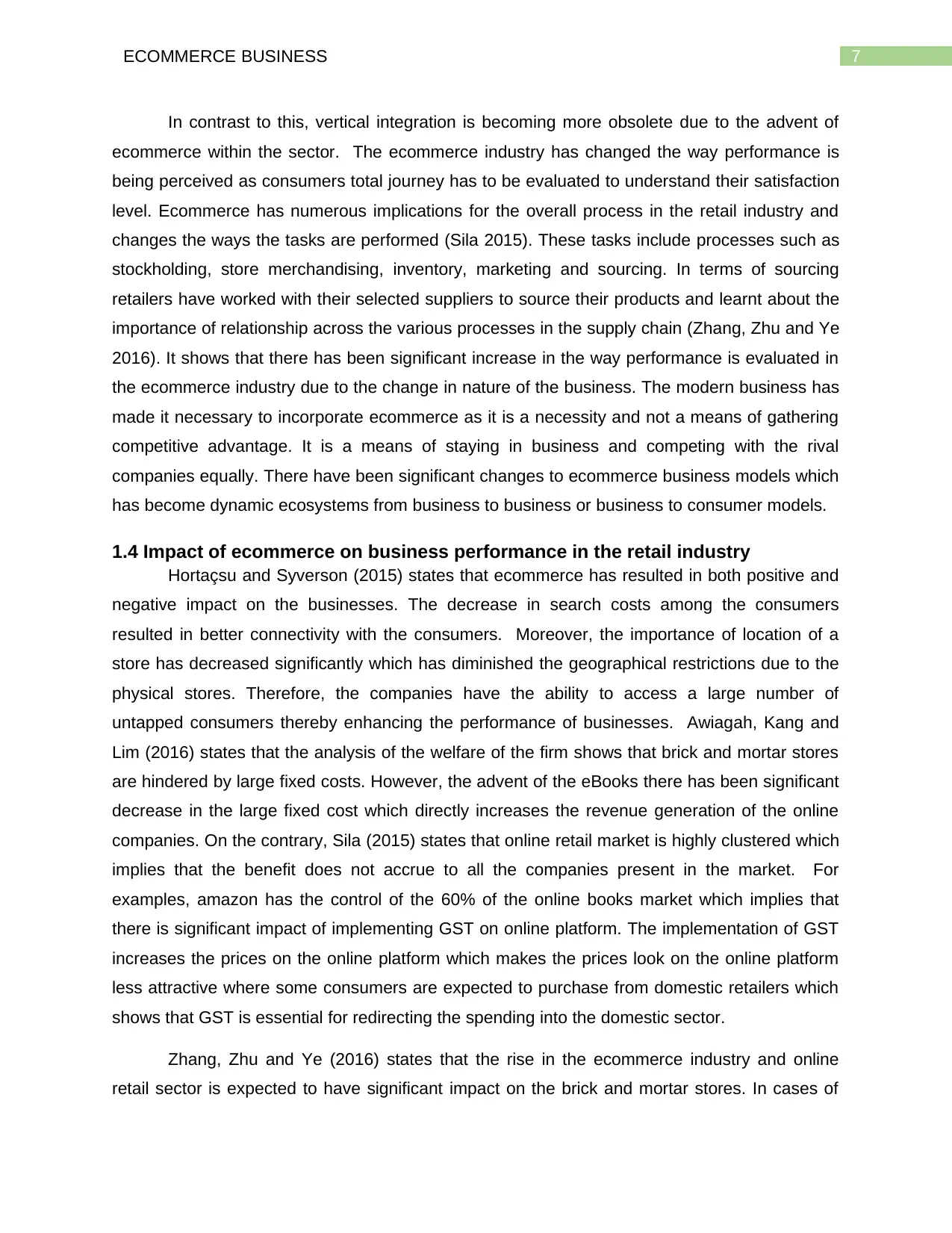
7ECOMMERCE BUSINESS
In contrast to this, vertical integration is becoming more obsolete due to the advent of
ecommerce within the sector. The ecommerce industry has changed the way performance is
being perceived as consumers total journey has to be evaluated to understand their satisfaction
level. Ecommerce has numerous implications for the overall process in the retail industry and
changes the ways the tasks are performed (Sila 2015). These tasks include processes such as
stockholding, store merchandising, inventory, marketing and sourcing. In terms of sourcing
retailers have worked with their selected suppliers to source their products and learnt about the
importance of relationship across the various processes in the supply chain (Zhang, Zhu and Ye
2016). It shows that there has been significant increase in the way performance is evaluated in
the ecommerce industry due to the change in nature of the business. The modern business has
made it necessary to incorporate ecommerce as it is a necessity and not a means of gathering
competitive advantage. It is a means of staying in business and competing with the rival
companies equally. There have been significant changes to ecommerce business models which
has become dynamic ecosystems from business to business or business to consumer models.
1.4 Impact of ecommerce on business performance in the retail industry
Hortaçsu and Syverson (2015) states that ecommerce has resulted in both positive and
negative impact on the businesses. The decrease in search costs among the consumers
resulted in better connectivity with the consumers. Moreover, the importance of location of a
store has decreased significantly which has diminished the geographical restrictions due to the
physical stores. Therefore, the companies have the ability to access a large number of
untapped consumers thereby enhancing the performance of businesses. Awiagah, Kang and
Lim (2016) states that the analysis of the welfare of the firm shows that brick and mortar stores
are hindered by large fixed costs. However, the advent of the eBooks there has been significant
decrease in the large fixed cost which directly increases the revenue generation of the online
companies. On the contrary, Sila (2015) states that online retail market is highly clustered which
implies that the benefit does not accrue to all the companies present in the market. For
examples, amazon has the control of the 60% of the online books market which implies that
there is significant impact of implementing GST on online platform. The implementation of GST
increases the prices on the online platform which makes the prices look on the online platform
less attractive where some consumers are expected to purchase from domestic retailers which
shows that GST is essential for redirecting the spending into the domestic sector.
Zhang, Zhu and Ye (2016) states that the rise in the ecommerce industry and online
retail sector is expected to have significant impact on the brick and mortar stores. In cases of
In contrast to this, vertical integration is becoming more obsolete due to the advent of
ecommerce within the sector. The ecommerce industry has changed the way performance is
being perceived as consumers total journey has to be evaluated to understand their satisfaction
level. Ecommerce has numerous implications for the overall process in the retail industry and
changes the ways the tasks are performed (Sila 2015). These tasks include processes such as
stockholding, store merchandising, inventory, marketing and sourcing. In terms of sourcing
retailers have worked with their selected suppliers to source their products and learnt about the
importance of relationship across the various processes in the supply chain (Zhang, Zhu and Ye
2016). It shows that there has been significant increase in the way performance is evaluated in
the ecommerce industry due to the change in nature of the business. The modern business has
made it necessary to incorporate ecommerce as it is a necessity and not a means of gathering
competitive advantage. It is a means of staying in business and competing with the rival
companies equally. There have been significant changes to ecommerce business models which
has become dynamic ecosystems from business to business or business to consumer models.
1.4 Impact of ecommerce on business performance in the retail industry
Hortaçsu and Syverson (2015) states that ecommerce has resulted in both positive and
negative impact on the businesses. The decrease in search costs among the consumers
resulted in better connectivity with the consumers. Moreover, the importance of location of a
store has decreased significantly which has diminished the geographical restrictions due to the
physical stores. Therefore, the companies have the ability to access a large number of
untapped consumers thereby enhancing the performance of businesses. Awiagah, Kang and
Lim (2016) states that the analysis of the welfare of the firm shows that brick and mortar stores
are hindered by large fixed costs. However, the advent of the eBooks there has been significant
decrease in the large fixed cost which directly increases the revenue generation of the online
companies. On the contrary, Sila (2015) states that online retail market is highly clustered which
implies that the benefit does not accrue to all the companies present in the market. For
examples, amazon has the control of the 60% of the online books market which implies that
there is significant impact of implementing GST on online platform. The implementation of GST
increases the prices on the online platform which makes the prices look on the online platform
less attractive where some consumers are expected to purchase from domestic retailers which
shows that GST is essential for redirecting the spending into the domestic sector.
Zhang, Zhu and Ye (2016) states that the rise in the ecommerce industry and online
retail sector is expected to have significant impact on the brick and mortar stores. In cases of
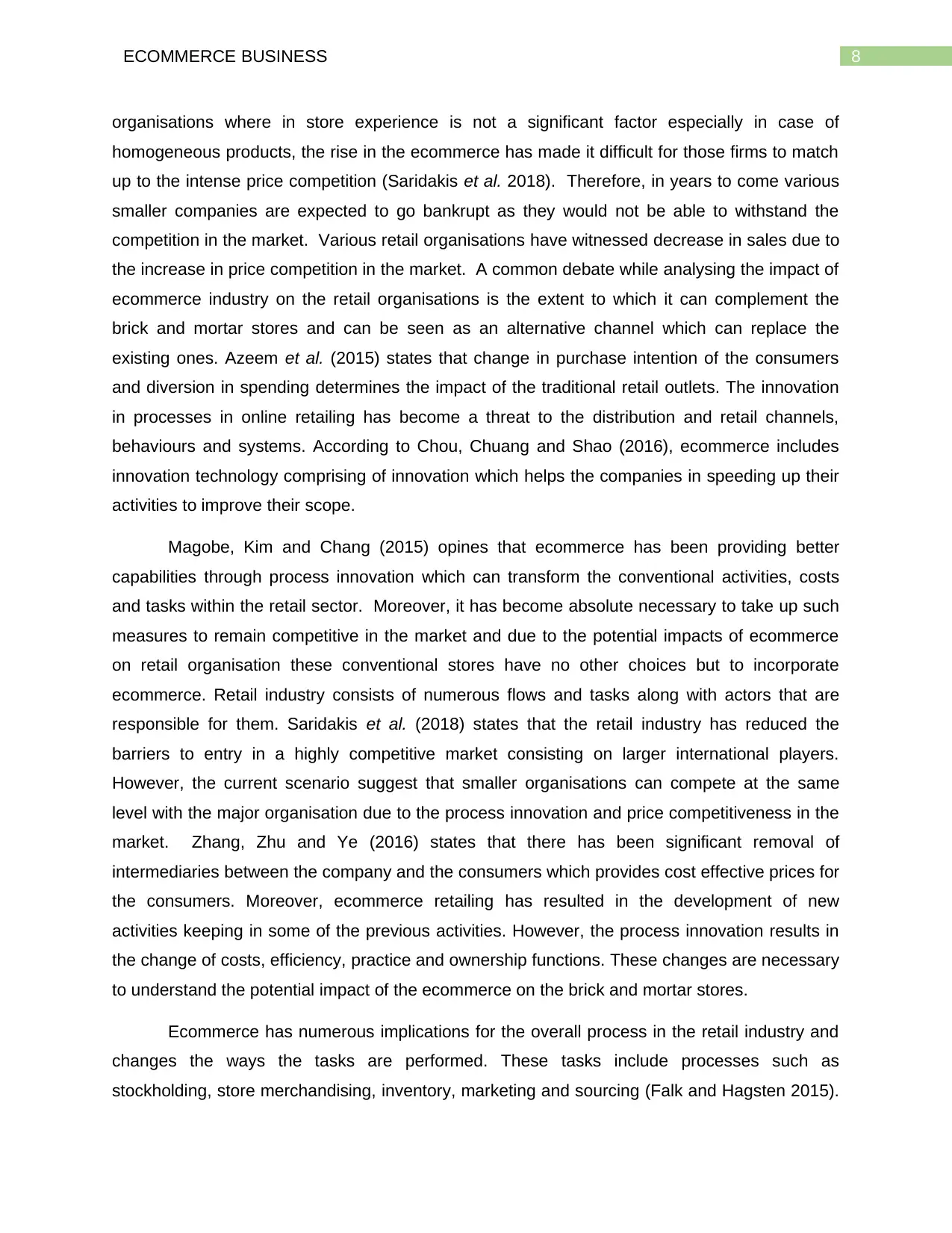
8ECOMMERCE BUSINESS
organisations where in store experience is not a significant factor especially in case of
homogeneous products, the rise in the ecommerce has made it difficult for those firms to match
up to the intense price competition (Saridakis et al. 2018). Therefore, in years to come various
smaller companies are expected to go bankrupt as they would not be able to withstand the
competition in the market. Various retail organisations have witnessed decrease in sales due to
the increase in price competition in the market. A common debate while analysing the impact of
ecommerce industry on the retail organisations is the extent to which it can complement the
brick and mortar stores and can be seen as an alternative channel which can replace the
existing ones. Azeem et al. (2015) states that change in purchase intention of the consumers
and diversion in spending determines the impact of the traditional retail outlets. The innovation
in processes in online retailing has become a threat to the distribution and retail channels,
behaviours and systems. According to Chou, Chuang and Shao (2016), ecommerce includes
innovation technology comprising of innovation which helps the companies in speeding up their
activities to improve their scope.
Magobe, Kim and Chang (2015) opines that ecommerce has been providing better
capabilities through process innovation which can transform the conventional activities, costs
and tasks within the retail sector. Moreover, it has become absolute necessary to take up such
measures to remain competitive in the market and due to the potential impacts of ecommerce
on retail organisation these conventional stores have no other choices but to incorporate
ecommerce. Retail industry consists of numerous flows and tasks along with actors that are
responsible for them. Saridakis et al. (2018) states that the retail industry has reduced the
barriers to entry in a highly competitive market consisting on larger international players.
However, the current scenario suggest that smaller organisations can compete at the same
level with the major organisation due to the process innovation and price competitiveness in the
market. Zhang, Zhu and Ye (2016) states that there has been significant removal of
intermediaries between the company and the consumers which provides cost effective prices for
the consumers. Moreover, ecommerce retailing has resulted in the development of new
activities keeping in some of the previous activities. However, the process innovation results in
the change of costs, efficiency, practice and ownership functions. These changes are necessary
to understand the potential impact of the ecommerce on the brick and mortar stores.
Ecommerce has numerous implications for the overall process in the retail industry and
changes the ways the tasks are performed. These tasks include processes such as
stockholding, store merchandising, inventory, marketing and sourcing (Falk and Hagsten 2015).
organisations where in store experience is not a significant factor especially in case of
homogeneous products, the rise in the ecommerce has made it difficult for those firms to match
up to the intense price competition (Saridakis et al. 2018). Therefore, in years to come various
smaller companies are expected to go bankrupt as they would not be able to withstand the
competition in the market. Various retail organisations have witnessed decrease in sales due to
the increase in price competition in the market. A common debate while analysing the impact of
ecommerce industry on the retail organisations is the extent to which it can complement the
brick and mortar stores and can be seen as an alternative channel which can replace the
existing ones. Azeem et al. (2015) states that change in purchase intention of the consumers
and diversion in spending determines the impact of the traditional retail outlets. The innovation
in processes in online retailing has become a threat to the distribution and retail channels,
behaviours and systems. According to Chou, Chuang and Shao (2016), ecommerce includes
innovation technology comprising of innovation which helps the companies in speeding up their
activities to improve their scope.
Magobe, Kim and Chang (2015) opines that ecommerce has been providing better
capabilities through process innovation which can transform the conventional activities, costs
and tasks within the retail sector. Moreover, it has become absolute necessary to take up such
measures to remain competitive in the market and due to the potential impacts of ecommerce
on retail organisation these conventional stores have no other choices but to incorporate
ecommerce. Retail industry consists of numerous flows and tasks along with actors that are
responsible for them. Saridakis et al. (2018) states that the retail industry has reduced the
barriers to entry in a highly competitive market consisting on larger international players.
However, the current scenario suggest that smaller organisations can compete at the same
level with the major organisation due to the process innovation and price competitiveness in the
market. Zhang, Zhu and Ye (2016) states that there has been significant removal of
intermediaries between the company and the consumers which provides cost effective prices for
the consumers. Moreover, ecommerce retailing has resulted in the development of new
activities keeping in some of the previous activities. However, the process innovation results in
the change of costs, efficiency, practice and ownership functions. These changes are necessary
to understand the potential impact of the ecommerce on the brick and mortar stores.
Ecommerce has numerous implications for the overall process in the retail industry and
changes the ways the tasks are performed. These tasks include processes such as
stockholding, store merchandising, inventory, marketing and sourcing (Falk and Hagsten 2015).
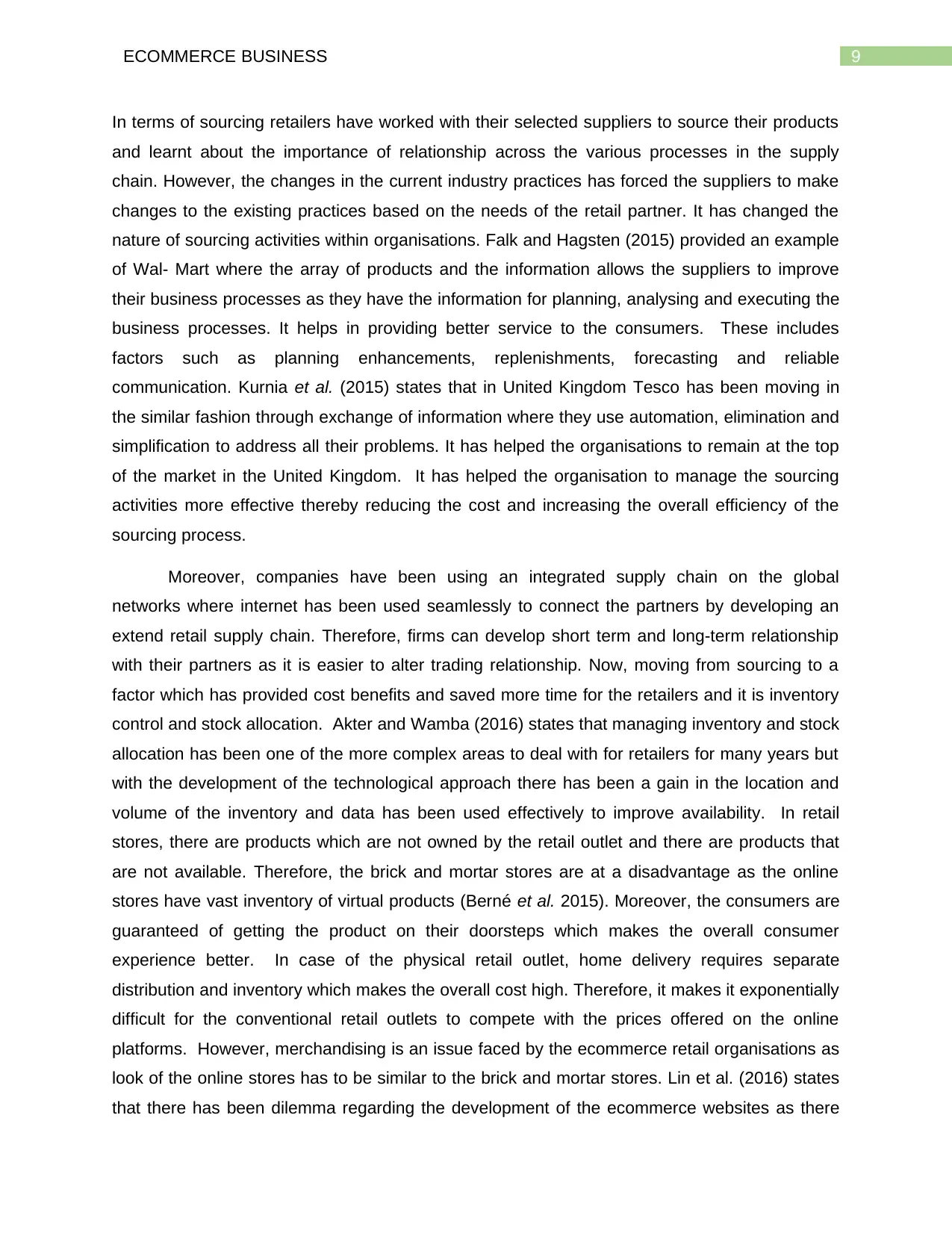
9ECOMMERCE BUSINESS
In terms of sourcing retailers have worked with their selected suppliers to source their products
and learnt about the importance of relationship across the various processes in the supply
chain. However, the changes in the current industry practices has forced the suppliers to make
changes to the existing practices based on the needs of the retail partner. It has changed the
nature of sourcing activities within organisations. Falk and Hagsten (2015) provided an example
of Wal- Mart where the array of products and the information allows the suppliers to improve
their business processes as they have the information for planning, analysing and executing the
business processes. It helps in providing better service to the consumers. These includes
factors such as planning enhancements, replenishments, forecasting and reliable
communication. Kurnia et al. (2015) states that in United Kingdom Tesco has been moving in
the similar fashion through exchange of information where they use automation, elimination and
simplification to address all their problems. It has helped the organisations to remain at the top
of the market in the United Kingdom. It has helped the organisation to manage the sourcing
activities more effective thereby reducing the cost and increasing the overall efficiency of the
sourcing process.
Moreover, companies have been using an integrated supply chain on the global
networks where internet has been used seamlessly to connect the partners by developing an
extend retail supply chain. Therefore, firms can develop short term and long-term relationship
with their partners as it is easier to alter trading relationship. Now, moving from sourcing to a
factor which has provided cost benefits and saved more time for the retailers and it is inventory
control and stock allocation. Akter and Wamba (2016) states that managing inventory and stock
allocation has been one of the more complex areas to deal with for retailers for many years but
with the development of the technological approach there has been a gain in the location and
volume of the inventory and data has been used effectively to improve availability. In retail
stores, there are products which are not owned by the retail outlet and there are products that
are not available. Therefore, the brick and mortar stores are at a disadvantage as the online
stores have vast inventory of virtual products (Berné et al. 2015). Moreover, the consumers are
guaranteed of getting the product on their doorsteps which makes the overall consumer
experience better. In case of the physical retail outlet, home delivery requires separate
distribution and inventory which makes the overall cost high. Therefore, it makes it exponentially
difficult for the conventional retail outlets to compete with the prices offered on the online
platforms. However, merchandising is an issue faced by the ecommerce retail organisations as
look of the online stores has to be similar to the brick and mortar stores. Lin et al. (2016) states
that there has been dilemma regarding the development of the ecommerce websites as there
In terms of sourcing retailers have worked with their selected suppliers to source their products
and learnt about the importance of relationship across the various processes in the supply
chain. However, the changes in the current industry practices has forced the suppliers to make
changes to the existing practices based on the needs of the retail partner. It has changed the
nature of sourcing activities within organisations. Falk and Hagsten (2015) provided an example
of Wal- Mart where the array of products and the information allows the suppliers to improve
their business processes as they have the information for planning, analysing and executing the
business processes. It helps in providing better service to the consumers. These includes
factors such as planning enhancements, replenishments, forecasting and reliable
communication. Kurnia et al. (2015) states that in United Kingdom Tesco has been moving in
the similar fashion through exchange of information where they use automation, elimination and
simplification to address all their problems. It has helped the organisations to remain at the top
of the market in the United Kingdom. It has helped the organisation to manage the sourcing
activities more effective thereby reducing the cost and increasing the overall efficiency of the
sourcing process.
Moreover, companies have been using an integrated supply chain on the global
networks where internet has been used seamlessly to connect the partners by developing an
extend retail supply chain. Therefore, firms can develop short term and long-term relationship
with their partners as it is easier to alter trading relationship. Now, moving from sourcing to a
factor which has provided cost benefits and saved more time for the retailers and it is inventory
control and stock allocation. Akter and Wamba (2016) states that managing inventory and stock
allocation has been one of the more complex areas to deal with for retailers for many years but
with the development of the technological approach there has been a gain in the location and
volume of the inventory and data has been used effectively to improve availability. In retail
stores, there are products which are not owned by the retail outlet and there are products that
are not available. Therefore, the brick and mortar stores are at a disadvantage as the online
stores have vast inventory of virtual products (Berné et al. 2015). Moreover, the consumers are
guaranteed of getting the product on their doorsteps which makes the overall consumer
experience better. In case of the physical retail outlet, home delivery requires separate
distribution and inventory which makes the overall cost high. Therefore, it makes it exponentially
difficult for the conventional retail outlets to compete with the prices offered on the online
platforms. However, merchandising is an issue faced by the ecommerce retail organisations as
look of the online stores has to be similar to the brick and mortar stores. Lin et al. (2016) states
that there has been dilemma regarding the development of the ecommerce websites as there
Secure Best Marks with AI Grader
Need help grading? Try our AI Grader for instant feedback on your assignments.
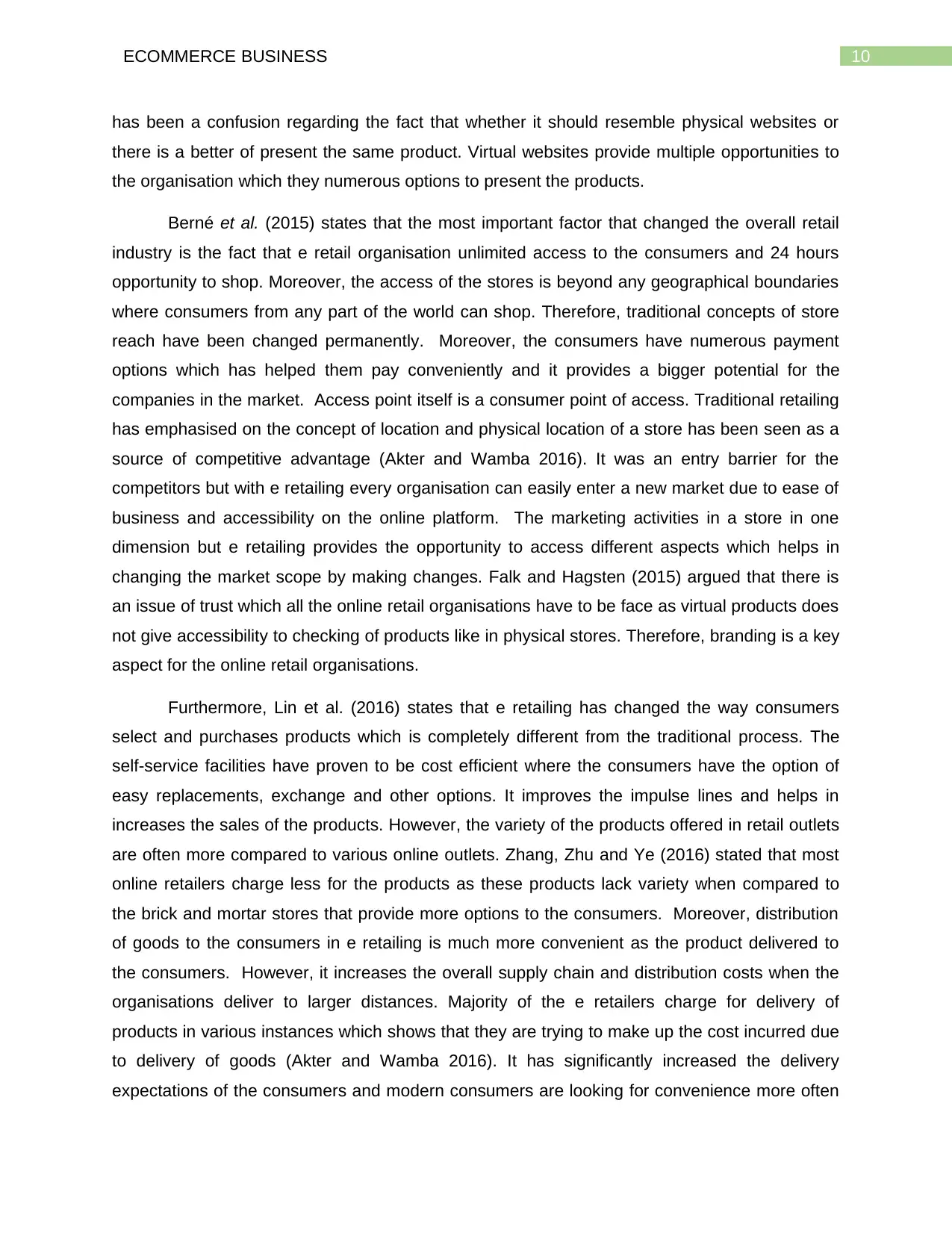
10ECOMMERCE BUSINESS
has been a confusion regarding the fact that whether it should resemble physical websites or
there is a better of present the same product. Virtual websites provide multiple opportunities to
the organisation which they numerous options to present the products.
Berné et al. (2015) states that the most important factor that changed the overall retail
industry is the fact that e retail organisation unlimited access to the consumers and 24 hours
opportunity to shop. Moreover, the access of the stores is beyond any geographical boundaries
where consumers from any part of the world can shop. Therefore, traditional concepts of store
reach have been changed permanently. Moreover, the consumers have numerous payment
options which has helped them pay conveniently and it provides a bigger potential for the
companies in the market. Access point itself is a consumer point of access. Traditional retailing
has emphasised on the concept of location and physical location of a store has been seen as a
source of competitive advantage (Akter and Wamba 2016). It was an entry barrier for the
competitors but with e retailing every organisation can easily enter a new market due to ease of
business and accessibility on the online platform. The marketing activities in a store in one
dimension but e retailing provides the opportunity to access different aspects which helps in
changing the market scope by making changes. Falk and Hagsten (2015) argued that there is
an issue of trust which all the online retail organisations have to be face as virtual products does
not give accessibility to checking of products like in physical stores. Therefore, branding is a key
aspect for the online retail organisations.
Furthermore, Lin et al. (2016) states that e retailing has changed the way consumers
select and purchases products which is completely different from the traditional process. The
self-service facilities have proven to be cost efficient where the consumers have the option of
easy replacements, exchange and other options. It improves the impulse lines and helps in
increases the sales of the products. However, the variety of the products offered in retail outlets
are often more compared to various online outlets. Zhang, Zhu and Ye (2016) stated that most
online retailers charge less for the products as these products lack variety when compared to
the brick and mortar stores that provide more options to the consumers. Moreover, distribution
of goods to the consumers in e retailing is much more convenient as the product delivered to
the consumers. However, it increases the overall supply chain and distribution costs when the
organisations deliver to larger distances. Majority of the e retailers charge for delivery of
products in various instances which shows that they are trying to make up the cost incurred due
to delivery of goods (Akter and Wamba 2016). It has significantly increased the delivery
expectations of the consumers and modern consumers are looking for convenience more often
has been a confusion regarding the fact that whether it should resemble physical websites or
there is a better of present the same product. Virtual websites provide multiple opportunities to
the organisation which they numerous options to present the products.
Berné et al. (2015) states that the most important factor that changed the overall retail
industry is the fact that e retail organisation unlimited access to the consumers and 24 hours
opportunity to shop. Moreover, the access of the stores is beyond any geographical boundaries
where consumers from any part of the world can shop. Therefore, traditional concepts of store
reach have been changed permanently. Moreover, the consumers have numerous payment
options which has helped them pay conveniently and it provides a bigger potential for the
companies in the market. Access point itself is a consumer point of access. Traditional retailing
has emphasised on the concept of location and physical location of a store has been seen as a
source of competitive advantage (Akter and Wamba 2016). It was an entry barrier for the
competitors but with e retailing every organisation can easily enter a new market due to ease of
business and accessibility on the online platform. The marketing activities in a store in one
dimension but e retailing provides the opportunity to access different aspects which helps in
changing the market scope by making changes. Falk and Hagsten (2015) argued that there is
an issue of trust which all the online retail organisations have to be face as virtual products does
not give accessibility to checking of products like in physical stores. Therefore, branding is a key
aspect for the online retail organisations.
Furthermore, Lin et al. (2016) states that e retailing has changed the way consumers
select and purchases products which is completely different from the traditional process. The
self-service facilities have proven to be cost efficient where the consumers have the option of
easy replacements, exchange and other options. It improves the impulse lines and helps in
increases the sales of the products. However, the variety of the products offered in retail outlets
are often more compared to various online outlets. Zhang, Zhu and Ye (2016) stated that most
online retailers charge less for the products as these products lack variety when compared to
the brick and mortar stores that provide more options to the consumers. Moreover, distribution
of goods to the consumers in e retailing is much more convenient as the product delivered to
the consumers. However, it increases the overall supply chain and distribution costs when the
organisations deliver to larger distances. Majority of the e retailers charge for delivery of
products in various instances which shows that they are trying to make up the cost incurred due
to delivery of goods (Akter and Wamba 2016). It has significantly increased the delivery
expectations of the consumers and modern consumers are looking for convenience more often
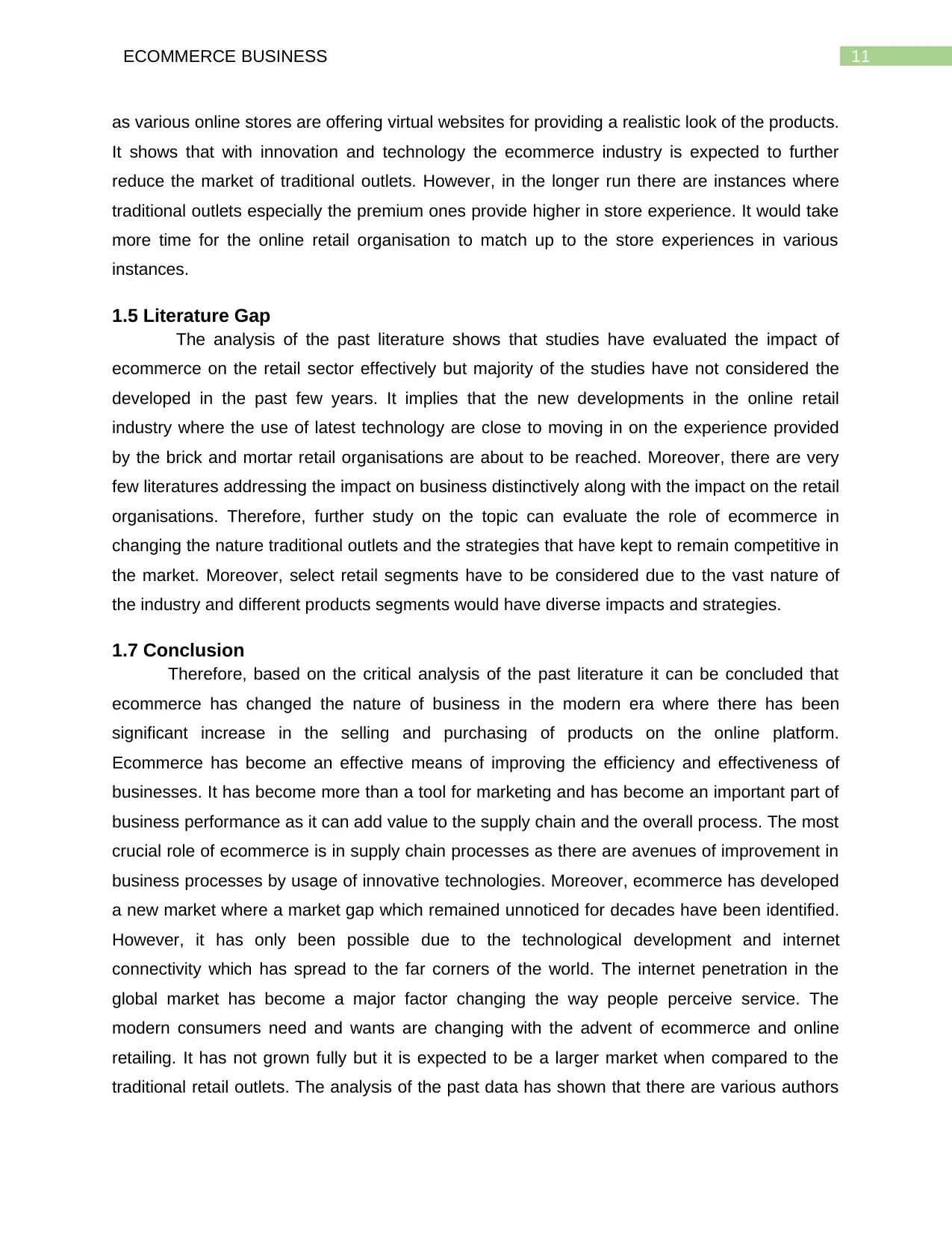
11ECOMMERCE BUSINESS
as various online stores are offering virtual websites for providing a realistic look of the products.
It shows that with innovation and technology the ecommerce industry is expected to further
reduce the market of traditional outlets. However, in the longer run there are instances where
traditional outlets especially the premium ones provide higher in store experience. It would take
more time for the online retail organisation to match up to the store experiences in various
instances.
1.5 Literature Gap
The analysis of the past literature shows that studies have evaluated the impact of
ecommerce on the retail sector effectively but majority of the studies have not considered the
developed in the past few years. It implies that the new developments in the online retail
industry where the use of latest technology are close to moving in on the experience provided
by the brick and mortar retail organisations are about to be reached. Moreover, there are very
few literatures addressing the impact on business distinctively along with the impact on the retail
organisations. Therefore, further study on the topic can evaluate the role of ecommerce in
changing the nature traditional outlets and the strategies that have kept to remain competitive in
the market. Moreover, select retail segments have to be considered due to the vast nature of
the industry and different products segments would have diverse impacts and strategies.
1.7 Conclusion
Therefore, based on the critical analysis of the past literature it can be concluded that
ecommerce has changed the nature of business in the modern era where there has been
significant increase in the selling and purchasing of products on the online platform.
Ecommerce has become an effective means of improving the efficiency and effectiveness of
businesses. It has become more than a tool for marketing and has become an important part of
business performance as it can add value to the supply chain and the overall process. The most
crucial role of ecommerce is in supply chain processes as there are avenues of improvement in
business processes by usage of innovative technologies. Moreover, ecommerce has developed
a new market where a market gap which remained unnoticed for decades have been identified.
However, it has only been possible due to the technological development and internet
connectivity which has spread to the far corners of the world. The internet penetration in the
global market has become a major factor changing the way people perceive service. The
modern consumers need and wants are changing with the advent of ecommerce and online
retailing. It has not grown fully but it is expected to be a larger market when compared to the
traditional retail outlets. The analysis of the past data has shown that there are various authors
as various online stores are offering virtual websites for providing a realistic look of the products.
It shows that with innovation and technology the ecommerce industry is expected to further
reduce the market of traditional outlets. However, in the longer run there are instances where
traditional outlets especially the premium ones provide higher in store experience. It would take
more time for the online retail organisation to match up to the store experiences in various
instances.
1.5 Literature Gap
The analysis of the past literature shows that studies have evaluated the impact of
ecommerce on the retail sector effectively but majority of the studies have not considered the
developed in the past few years. It implies that the new developments in the online retail
industry where the use of latest technology are close to moving in on the experience provided
by the brick and mortar retail organisations are about to be reached. Moreover, there are very
few literatures addressing the impact on business distinctively along with the impact on the retail
organisations. Therefore, further study on the topic can evaluate the role of ecommerce in
changing the nature traditional outlets and the strategies that have kept to remain competitive in
the market. Moreover, select retail segments have to be considered due to the vast nature of
the industry and different products segments would have diverse impacts and strategies.
1.7 Conclusion
Therefore, based on the critical analysis of the past literature it can be concluded that
ecommerce has changed the nature of business in the modern era where there has been
significant increase in the selling and purchasing of products on the online platform.
Ecommerce has become an effective means of improving the efficiency and effectiveness of
businesses. It has become more than a tool for marketing and has become an important part of
business performance as it can add value to the supply chain and the overall process. The most
crucial role of ecommerce is in supply chain processes as there are avenues of improvement in
business processes by usage of innovative technologies. Moreover, ecommerce has developed
a new market where a market gap which remained unnoticed for decades have been identified.
However, it has only been possible due to the technological development and internet
connectivity which has spread to the far corners of the world. The internet penetration in the
global market has become a major factor changing the way people perceive service. The
modern consumers need and wants are changing with the advent of ecommerce and online
retailing. It has not grown fully but it is expected to be a larger market when compared to the
traditional retail outlets. The analysis of the past data has shown that there are various authors

12ECOMMERCE BUSINESS
who consider traditional outlet as a obsolete market and e retailing is the future whereas some
consider traditional stores to keep their due to their store experience.
who consider traditional outlet as a obsolete market and e retailing is the future whereas some
consider traditional stores to keep their due to their store experience.
Paraphrase This Document
Need a fresh take? Get an instant paraphrase of this document with our AI Paraphraser
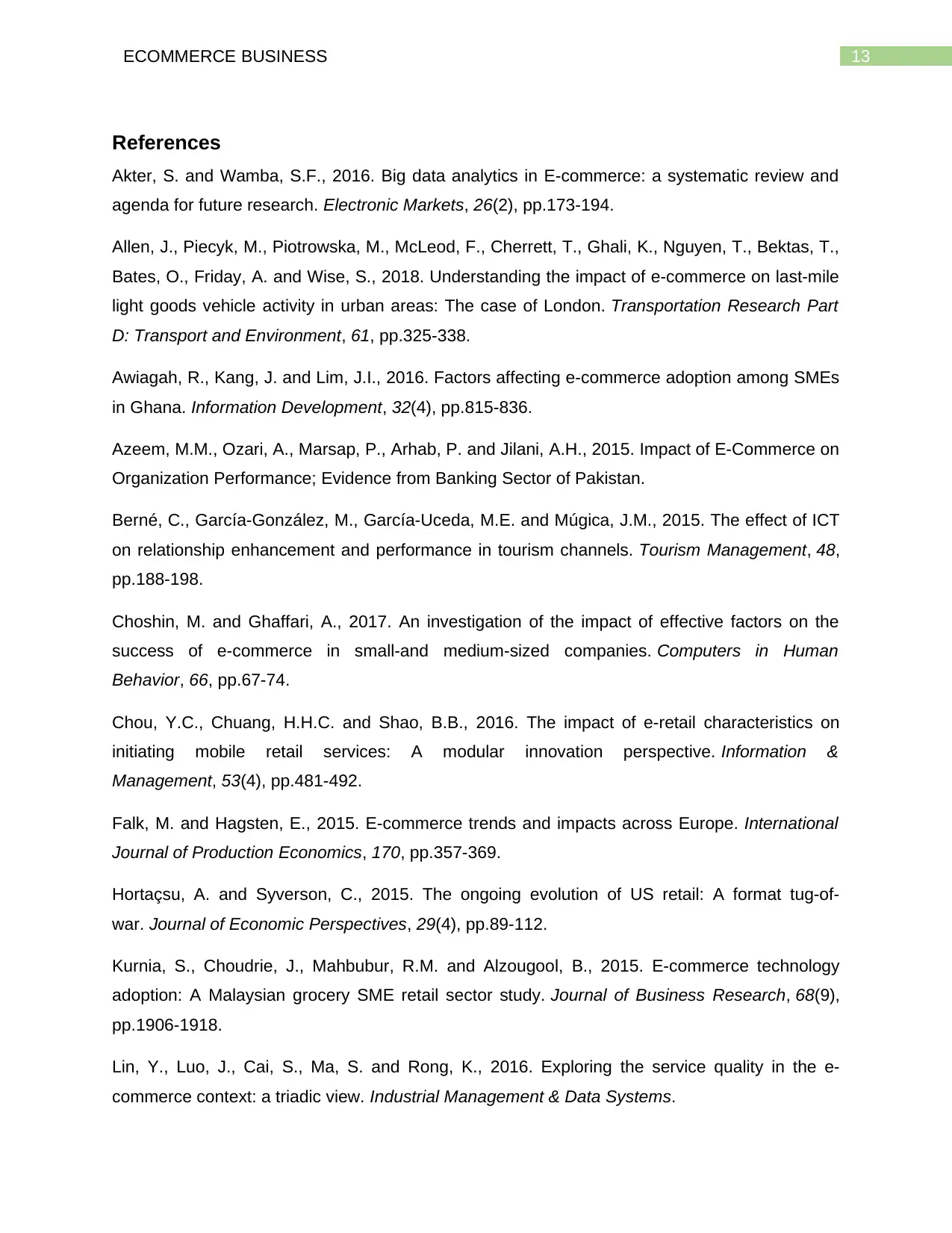
13ECOMMERCE BUSINESS
References
Akter, S. and Wamba, S.F., 2016. Big data analytics in E-commerce: a systematic review and
agenda for future research. Electronic Markets, 26(2), pp.173-194.
Allen, J., Piecyk, M., Piotrowska, M., McLeod, F., Cherrett, T., Ghali, K., Nguyen, T., Bektas, T.,
Bates, O., Friday, A. and Wise, S., 2018. Understanding the impact of e-commerce on last-mile
light goods vehicle activity in urban areas: The case of London. Transportation Research Part
D: Transport and Environment, 61, pp.325-338.
Awiagah, R., Kang, J. and Lim, J.I., 2016. Factors affecting e-commerce adoption among SMEs
in Ghana. Information Development, 32(4), pp.815-836.
Azeem, M.M., Ozari, A., Marsap, P., Arhab, P. and Jilani, A.H., 2015. Impact of E-Commerce on
Organization Performance; Evidence from Banking Sector of Pakistan.
Berné, C., García-González, M., García-Uceda, M.E. and Múgica, J.M., 2015. The effect of ICT
on relationship enhancement and performance in tourism channels. Tourism Management, 48,
pp.188-198.
Choshin, M. and Ghaffari, A., 2017. An investigation of the impact of effective factors on the
success of e-commerce in small-and medium-sized companies. Computers in Human
Behavior, 66, pp.67-74.
Chou, Y.C., Chuang, H.H.C. and Shao, B.B., 2016. The impact of e-retail characteristics on
initiating mobile retail services: A modular innovation perspective. Information &
Management, 53(4), pp.481-492.
Falk, M. and Hagsten, E., 2015. E-commerce trends and impacts across Europe. International
Journal of Production Economics, 170, pp.357-369.
Hortaçsu, A. and Syverson, C., 2015. The ongoing evolution of US retail: A format tug-of-
war. Journal of Economic Perspectives, 29(4), pp.89-112.
Kurnia, S., Choudrie, J., Mahbubur, R.M. and Alzougool, B., 2015. E-commerce technology
adoption: A Malaysian grocery SME retail sector study. Journal of Business Research, 68(9),
pp.1906-1918.
Lin, Y., Luo, J., Cai, S., Ma, S. and Rong, K., 2016. Exploring the service quality in the e-
commerce context: a triadic view. Industrial Management & Data Systems.
References
Akter, S. and Wamba, S.F., 2016. Big data analytics in E-commerce: a systematic review and
agenda for future research. Electronic Markets, 26(2), pp.173-194.
Allen, J., Piecyk, M., Piotrowska, M., McLeod, F., Cherrett, T., Ghali, K., Nguyen, T., Bektas, T.,
Bates, O., Friday, A. and Wise, S., 2018. Understanding the impact of e-commerce on last-mile
light goods vehicle activity in urban areas: The case of London. Transportation Research Part
D: Transport and Environment, 61, pp.325-338.
Awiagah, R., Kang, J. and Lim, J.I., 2016. Factors affecting e-commerce adoption among SMEs
in Ghana. Information Development, 32(4), pp.815-836.
Azeem, M.M., Ozari, A., Marsap, P., Arhab, P. and Jilani, A.H., 2015. Impact of E-Commerce on
Organization Performance; Evidence from Banking Sector of Pakistan.
Berné, C., García-González, M., García-Uceda, M.E. and Múgica, J.M., 2015. The effect of ICT
on relationship enhancement and performance in tourism channels. Tourism Management, 48,
pp.188-198.
Choshin, M. and Ghaffari, A., 2017. An investigation of the impact of effective factors on the
success of e-commerce in small-and medium-sized companies. Computers in Human
Behavior, 66, pp.67-74.
Chou, Y.C., Chuang, H.H.C. and Shao, B.B., 2016. The impact of e-retail characteristics on
initiating mobile retail services: A modular innovation perspective. Information &
Management, 53(4), pp.481-492.
Falk, M. and Hagsten, E., 2015. E-commerce trends and impacts across Europe. International
Journal of Production Economics, 170, pp.357-369.
Hortaçsu, A. and Syverson, C., 2015. The ongoing evolution of US retail: A format tug-of-
war. Journal of Economic Perspectives, 29(4), pp.89-112.
Kurnia, S., Choudrie, J., Mahbubur, R.M. and Alzougool, B., 2015. E-commerce technology
adoption: A Malaysian grocery SME retail sector study. Journal of Business Research, 68(9),
pp.1906-1918.
Lin, Y., Luo, J., Cai, S., Ma, S. and Rong, K., 2016. Exploring the service quality in the e-
commerce context: a triadic view. Industrial Management & Data Systems.
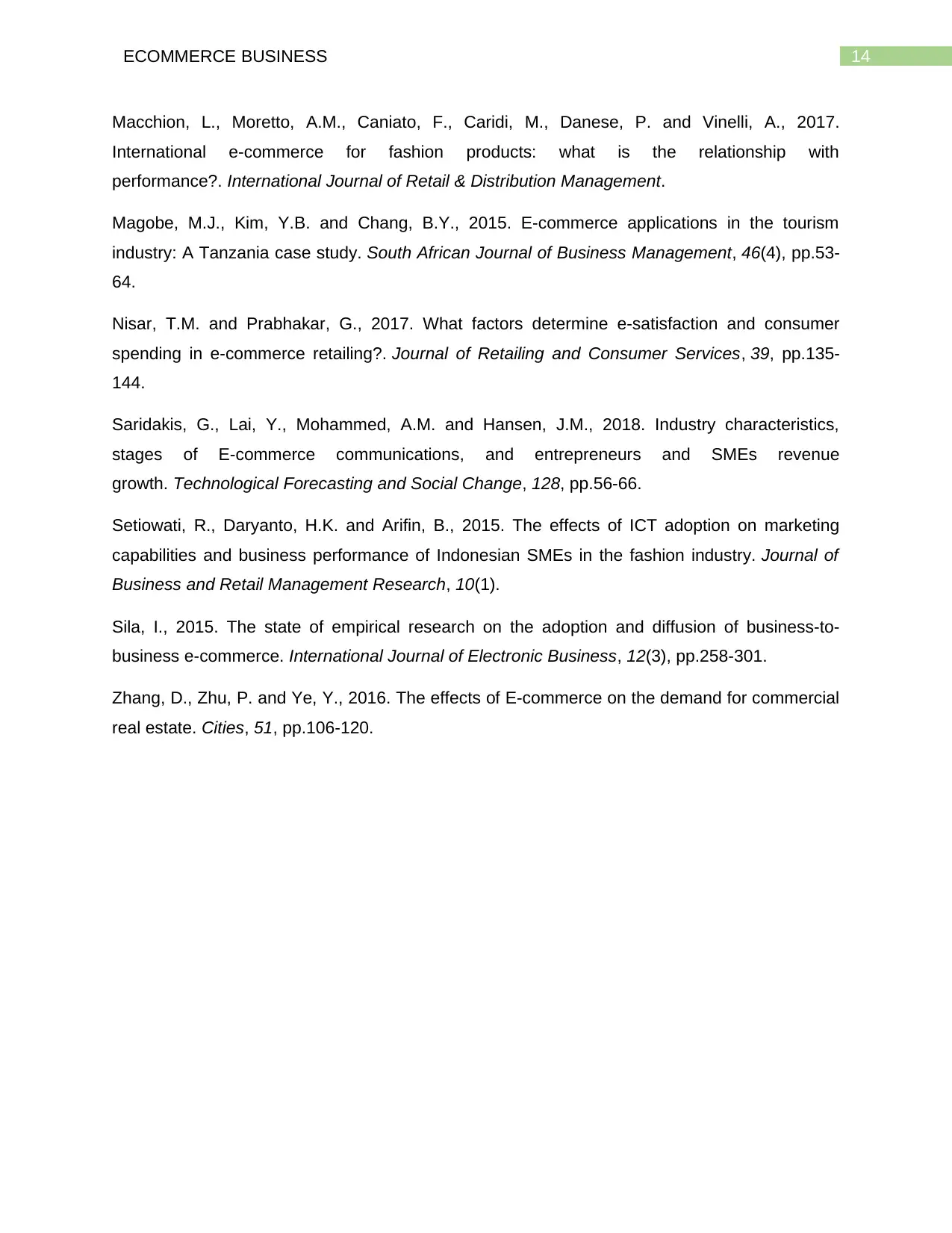
14ECOMMERCE BUSINESS
Macchion, L., Moretto, A.M., Caniato, F., Caridi, M., Danese, P. and Vinelli, A., 2017.
International e-commerce for fashion products: what is the relationship with
performance?. International Journal of Retail & Distribution Management.
Magobe, M.J., Kim, Y.B. and Chang, B.Y., 2015. E-commerce applications in the tourism
industry: A Tanzania case study. South African Journal of Business Management, 46(4), pp.53-
64.
Nisar, T.M. and Prabhakar, G., 2017. What factors determine e-satisfaction and consumer
spending in e-commerce retailing?. Journal of Retailing and Consumer Services, 39, pp.135-
144.
Saridakis, G., Lai, Y., Mohammed, A.M. and Hansen, J.M., 2018. Industry characteristics,
stages of E-commerce communications, and entrepreneurs and SMEs revenue
growth. Technological Forecasting and Social Change, 128, pp.56-66.
Setiowati, R., Daryanto, H.K. and Arifin, B., 2015. The effects of ICT adoption on marketing
capabilities and business performance of Indonesian SMEs in the fashion industry. Journal of
Business and Retail Management Research, 10(1).
Sila, I., 2015. The state of empirical research on the adoption and diffusion of business-to-
business e-commerce. International Journal of Electronic Business, 12(3), pp.258-301.
Zhang, D., Zhu, P. and Ye, Y., 2016. The effects of E-commerce on the demand for commercial
real estate. Cities, 51, pp.106-120.
Macchion, L., Moretto, A.M., Caniato, F., Caridi, M., Danese, P. and Vinelli, A., 2017.
International e-commerce for fashion products: what is the relationship with
performance?. International Journal of Retail & Distribution Management.
Magobe, M.J., Kim, Y.B. and Chang, B.Y., 2015. E-commerce applications in the tourism
industry: A Tanzania case study. South African Journal of Business Management, 46(4), pp.53-
64.
Nisar, T.M. and Prabhakar, G., 2017. What factors determine e-satisfaction and consumer
spending in e-commerce retailing?. Journal of Retailing and Consumer Services, 39, pp.135-
144.
Saridakis, G., Lai, Y., Mohammed, A.M. and Hansen, J.M., 2018. Industry characteristics,
stages of E-commerce communications, and entrepreneurs and SMEs revenue
growth. Technological Forecasting and Social Change, 128, pp.56-66.
Setiowati, R., Daryanto, H.K. and Arifin, B., 2015. The effects of ICT adoption on marketing
capabilities and business performance of Indonesian SMEs in the fashion industry. Journal of
Business and Retail Management Research, 10(1).
Sila, I., 2015. The state of empirical research on the adoption and diffusion of business-to-
business e-commerce. International Journal of Electronic Business, 12(3), pp.258-301.
Zhang, D., Zhu, P. and Ye, Y., 2016. The effects of E-commerce on the demand for commercial
real estate. Cities, 51, pp.106-120.
1 out of 15
Your All-in-One AI-Powered Toolkit for Academic Success.
+13062052269
info@desklib.com
Available 24*7 on WhatsApp / Email
![[object Object]](/_next/static/media/star-bottom.7253800d.svg)
Unlock your academic potential
© 2024 | Zucol Services PVT LTD | All rights reserved.





